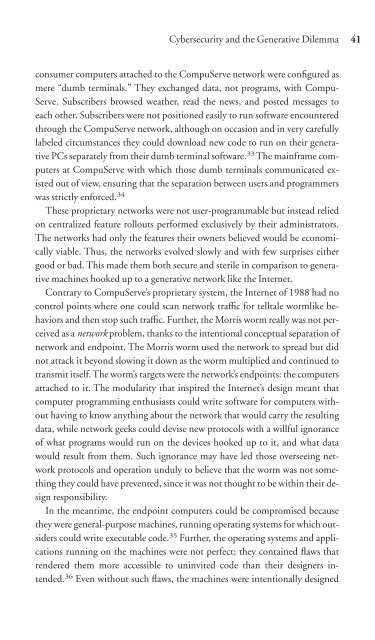Download - Future of the Internet â And how to stop it.
Download - Future of the Internet â And how to stop it.
Download - Future of the Internet â And how to stop it.
Create successful ePaper yourself
Turn your PDF publications into a flip-book with our unique Google optimized e-Paper software.
Cybersecur<strong>it</strong>y and <strong>the</strong> Generative Dilemma 41<br />
consumer computers attached <strong>to</strong> <strong>the</strong> CompuServe network were configured as<br />
mere “dumb terminals.” They exchanged data, not programs, w<strong>it</strong>h Compu-<br />
Serve. Subscribers browsed wea<strong>the</strong>r, read <strong>the</strong> news, and posted messages <strong>to</strong><br />
each o<strong>the</strong>r. Subscribers were not pos<strong>it</strong>ioned easily <strong>to</strong> run s<strong>of</strong>tware encountered<br />
through <strong>the</strong> CompuServe network, although on occasion and in very carefully<br />
labeled circumstances <strong>the</strong>y could download new code <strong>to</strong> run on <strong>the</strong>ir generative<br />
PCs separately from <strong>the</strong>ir dumb terminal s<strong>of</strong>tware. 33 The mainframe computers<br />
at CompuServe w<strong>it</strong>h which those dumb terminals communicated existed<br />
out <strong>of</strong> view, ensuring that <strong>the</strong> separation between users and programmers<br />
was strictly enforced. 34<br />
These proprietary networks were not user-programmable but instead relied<br />
on centralized feature rollouts performed exclusively by <strong>the</strong>ir administra<strong>to</strong>rs.<br />
The networks had only <strong>the</strong> features <strong>the</strong>ir owners believed would be economically<br />
viable. Thus, <strong>the</strong> networks evolved slowly and w<strong>it</strong>h few surprises ei<strong>the</strong>r<br />
good or bad. This made <strong>the</strong>m both secure and sterile in comparison <strong>to</strong> generative<br />
machines hooked up <strong>to</strong> a generative network like <strong>the</strong> <strong>Internet</strong>.<br />
Contrary <strong>to</strong> CompuServe’s proprietary system, <strong>the</strong> <strong>Internet</strong> <strong>of</strong> 1988 had no<br />
control points where one could scan network traffic for telltale wormlike behaviors<br />
and <strong>the</strong>n s<strong>to</strong>p such traffic. Fur<strong>the</strong>r, <strong>the</strong> Morris worm really was not perceived<br />
as a network problem, thanks <strong>to</strong> <strong>the</strong> intentional conceptual separation <strong>of</strong><br />
network and endpoint. The Morris worm used <strong>the</strong> network <strong>to</strong> spread but did<br />
not attack <strong>it</strong> beyond slowing <strong>it</strong> down as <strong>the</strong> worm multiplied and continued <strong>to</strong><br />
transm<strong>it</strong> <strong>it</strong>self. The worm’s targets were <strong>the</strong> network’s endpoints: <strong>the</strong> computers<br />
attached <strong>to</strong> <strong>it</strong>. The modular<strong>it</strong>y that inspired <strong>the</strong> <strong>Internet</strong>’s design meant that<br />
computer programming enthusiasts could wr<strong>it</strong>e s<strong>of</strong>tware for computers w<strong>it</strong>hout<br />
having <strong>to</strong> know anything about <strong>the</strong> network that would carry <strong>the</strong> resulting<br />
data, while network geeks could devise new pro<strong>to</strong>cols w<strong>it</strong>h a willful ignorance<br />
<strong>of</strong> what programs would run on <strong>the</strong> devices hooked up <strong>to</strong> <strong>it</strong>, and what data<br />
would result from <strong>the</strong>m. Such ignorance may have led those overseeing network<br />
pro<strong>to</strong>cols and operation unduly <strong>to</strong> believe that <strong>the</strong> worm was not something<br />
<strong>the</strong>y could have prevented, since <strong>it</strong> was not thought <strong>to</strong> be w<strong>it</strong>hin <strong>the</strong>ir design<br />
responsibil<strong>it</strong>y.<br />
In <strong>the</strong> meantime, <strong>the</strong> endpoint computers could be compromised because<br />
<strong>the</strong>y were general-purpose machines, running operating systems for which outsiders<br />
could wr<strong>it</strong>e executable code. 35 Fur<strong>the</strong>r, <strong>the</strong> operating systems and applications<br />
running on <strong>the</strong> machines were not perfect; <strong>the</strong>y contained flaws that<br />
rendered <strong>the</strong>m more accessible <strong>to</strong> uninv<strong>it</strong>ed code than <strong>the</strong>ir designers intended.<br />
36 Even w<strong>it</strong>hout such flaws, <strong>the</strong> machines were intentionally designed


